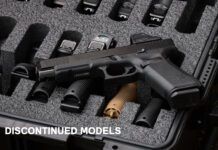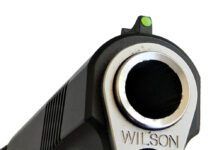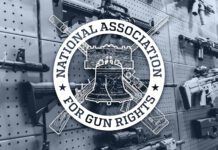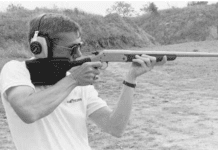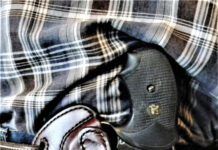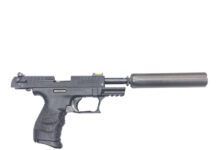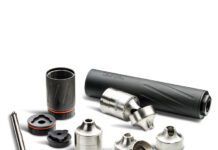When it comes to 45 ACP semi-automatics, we’re always looking for ways to fill our holsters without emptying our bank accounts. There are many 45s that cost about $1200, and it’s not hard to find 45s that cost twice that or more. In this test we will look at three affordable 45s with suggested retail prices that are well under the $1000 mark. Aside from categorizing by price, both the $650 Beretta PX4 Storm F and the $874 CZ 97BD could also be categorized as traditional double action (TDA) guns. We compared these guns to a $600 single-action 1911, the new Para USA GI Expert.
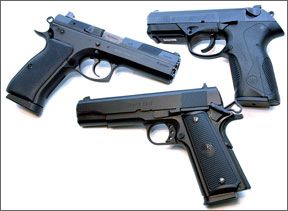
We followed the same test procedure as our last evaluation of 45 ACP pistols published in the April 2009 issue. We fired five-shot groups from a bench at targets 15 yards downrange. Then, we put our guns through an action test of firing 10 three-shot strings standing offhand at an IPSC Metric target 7 yards away. Using a shot-activated electronic timer, we began with the pistol held chest high with both hands. Upon an audible start signal, we pushed the gun toward the target and attempted to land two hits inside the 5.9-inch-wide by 11.1-inch-high A-zone located at center mass, followed by a single shot to the B-zone, which delineated the head area of our target. This area was 6.4 inches by 6.9 inches. We’ve used this procedure many times before and think it offers valuable insight into what is required to bring the gun into action. We shot this test at the Impact Zone in Monaville, Texas.
What proved more difficult than formulating a test procedure was finding ammunition. Supplies of popular calibers such as 45 ACP have all but dried up. If we hadn’t visited Top Gun in Houston, we may not have been able to find any reasonably priced ammunition at all. To test we purchased a supply of Hornady 200-grain XTP hollowpoints for about $22 per 20-round box. We handloaded two other test rounds. They consisted of cases topped with Zero brand 185-grain jacketed hollowpoints and 200-grain roundnosed lead bullets by Bushwacker. Each round was powered by Winchester 231 powder with charges about midway between the starting load and the maximum load, as per Hodgdon’s latest load data. We used Winchester large pistol primers, and the rounds were loaded on a Dillon Precision Super 1050. Both our handloads were previously developed for competition, so we knew our rounds would be safe and accurate. Throughout our tests, all three guns performed without malfunction, so we were able to concentrate on the handling and performance of each pistol. Here is what we found in our side-by-side evaluations:
Beretta PX4 Storm F JXF5F25 45 ACP, $650
The PX4 Storm F is a polymer-framed pistol with hammer ignition that offers three interchangeable backstraps, an accessory rail, and decocker/safety levers mounted on each side of the slide. This may not sound unusual but the grip and the futuristic styling sets it apart. Furthermore, the barrel rotates out of battery. This means the barrel remains in line throughout the cycling process, limiting the amount of effort necessary to regain proper lockup and alignment of the barrel.
Other features included a magazine release that can be mounted on either side. A higher-profile release button was also available but not included in the basic package. A military version of this same pistol, the PX4 Storm SD, retails for $1075 and that unit includes night sights.
Our Beretta had white-dot sights that were dovetailed into place. Cocking serrations on the slide were understated but in place front and rear. Two double-column magazines were supplied. One had a flat basepad that held nine rounds. The 10-round magazine was fit with a basepad that added to the length of the grip and looked like it should hold more than one additional round. The entire pistol was black, thereby hiding its handsome sculpted profiles.
Before taking the PX4 to the range, we changed the backstrap to the smallest of the three panels. The largest panel added to the beavertail, or in this case the point where the frame contoured over the web of our hands. The smallest panel offered a flatter surface to the backstrap. Removing the panel the first time was a bit of a chore. A U-shaped wire secured the panel, and it took finding the right flat screwdriver to unseat it. Once the wire was removed, the panel slid off but with a fair amount of effort.
Next, we removed the top end to make sure the pistol was properly lubricated. The top end of the PX4 Storm F was removed by exactly the same means as we would strip a Glock pistol. The only difference we found was that it was easier to pull down on the release tabs. We moved the slide rearward about a quarter-inch and pulled down on the release tabs located on the frame just ahead of the trigger guard. Just that easy, the slide was free to move forward and separate. Reassembly meant simply sliding the top end back on to the frame. With the slide lying upside down, we pulled away the recoil assembly. This consisted of a spring captured on a polymer guide rod. This unit was threaded through a steel block. A lug was machined into the side that faced the barrel. This lug rode in the channel that spiraled partially around the bottom of the barrel. As the slide moved forward and back, the lug stayed in position, causing the barrel to rotate. We applied only a small amount of lubricant to the four primary contact points between the frame and slide. Applying oil to the lug was imperative. We first saw this design on a Beretta pistol when we tested a Cougar in the December 1999 issue. We liked the original Cougar 45 okay, but we liked this gun better. In our opinion, the PX4 Storm F was softer recoiling and easier to control. It is possible that the longer barrel and slide of the PX4 offered more suitable timing for the rotating barrel system than the shorter Cougar pistol.
At the bench we fired single action only to collect accuracy data. With the Beretta seated in our Caldwell Jr. pistol rest, we produced our best accuracy firing the 185-grain handloads. The average size group was about 1.3 inches across. Some European-made barrels utilize polygonal rifling, which tends to foul quickly when shot with lead bullets. Both our CZ and Beretta pistols were barreled with standard rifling, and they handled the lead bullets without any problem. The PX4 fired the 200-grain RNL bullets into groups that varied as little as 1.3 to 1.6 inches across. Firing the Hornady ammunition, the gap between smallest and largest group was even less, 1.5 to 1.7 inches across on a consistent basis.
In our action test, wherein we were changing from double-action to single-action fire, we became aware of perhaps the only characteristic of the PX4 Storm F that bothered us. Each time we racked the slide to prepare for a string of fire, we had to press the decocker downward and then up again. We like being able to turn the gun completely off, but having to turn it back on every time we used the decocker did get tiresome. Also, we found racking the slide to be uncomfortable. It is impossible to pull back the slide without making contact with the decocking levers. The way they stuck out did make for a sure grip, but this also made the rear cocking serrations unnecessary. The decocking levers on the G-type models can be changed out for a slimmer profile set of levers. But we were unable to get a picture of them, and they are only available for the 9mm and 40 S&W models. If we could reconfigure the levers on our Storm F, we’d be much happier with this pistol.
In terms of performance during our action test, we did push 5/20 center mass shots slightly left, but the head shots fired single action were all in place. Our fastest run timed out at 2.14 seconds. We found we could ensure three hits with an elapsed time of about 2.30 seconds. We were able to perform this feat with the other guns in less than 2 seconds. One reason we think was that when decocked, the hammer was seated all the way forward. The hammer on our CZ, the other TDA gun in the test, decocked to a position away from the firing pin. The Beretta hammer was simply not as easy to move, and it had to travel further before striking the firing pin.
Our Team Said: The overall package of the Beretta PX4 Storm F was very good, but we’d like to see performance upgrades that would make it more appealing to the serious operator. The Beretta decocker/safety mechanism offered the most effective safety system, but our team would prefer lower-profile decocking levers that would make pulling back the slide more comfortable. In addition, the shooter must master the long trigger pull required for the double-action first shot.
CZ 97BD No. 01406 45 ACP, $874
The CZ 97BD is the decocker version of the model 97B tested in the April issue. The 97 series was based on the CZ75 design which, like the Browning 1911, is a classic in its own right. The primary difference between the model 97B and the 97BD is that the decocker lever on the 97BD allows the shooter to lower the hammer to a half-cock position without having to physically manipulate the hammer and the trigger.
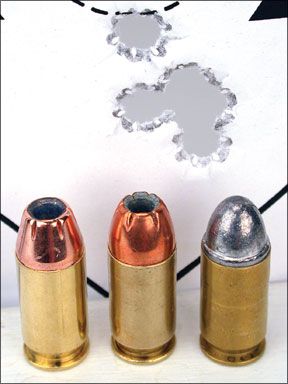
To review, once a round was chambered in the model 97B, the pistol could be made safe in one of two ways, by raising the thumb safeties or by lowering the hammer manually. This meant holding on to the hammer while pressing the trigger. We think most people will agree that using a decocker would be the safer option.
Besides the decocker (left side only), the 97BD also comes standard with self-illuminating tritium night sights. The front sight was fit into the slide from the front. The rear unit, which we found vastly superior in definition compared to the standard unit, was dovetailed in from the sides. Another new feature was the pop-up loaded-chamber indicator. Until we touched the grip of the 97BD, we had no idea the panels were rubber. Visually, they melted into the frame, offering full checkering and a flat profile that we liked. Two double-column 10-round magazines were supplied.
We found the 97BD to be very controllable. Of our three test pistols, we think it shot our test rounds with the least amount of felt recoil. The barrel was supported at the muzzle end by a bushing that screwed into the slide. Slide-to-frame fit also ran from one end of the slide to the other. The CZ design features frame rails that embraced the slide by reaching upward and over the slide. The rails were not exposed except during the act of cycling or when the slide was locked back.
Removing the top end requires moving the slide less than a half inch to the rear and pushing out the slide stop pin from right to left, using the basepad of a magazine. A tight slide stop pin does play a role in lockup and to some degree the accuracy of this design. Stripping out the barrel starts with removing the recoil spring and the capture bushing below the muzzle, referred to in the owner’s manual as the recoil spring housing. Then the barrel bushing can be unscrewed. A wrench for this purpose is supplied but will likely never be used. That is because the barrel bushing is backed off from the full lock position when it is properly installed. The recoil housing acts as a stop, locking into one of six cutouts found on the outer ring of the barrel bushing. We liked this design because two stress points (the barrel bushing and the slide stop pin) can be easily replaced or refit to restore or improve performance.
From the bench our handloaded target rounds brought us groups measuring about 1.25 inches across on average. We thought this performance was satisfactory, but we were more interested in how our CZ97BD would handle our choice of defensive ammunition. The difference in accuracy was impressive. Shooting the 200-grain Hornady Custom XTP ammunition, group size broke the 1.0-inch barrier, varying in diameter as little as between 0.8 inch to 1.0 inches across. We don’t always find the optimum bullet, bullet weight or the most accurate load, but we think we did in this case.
In the April 2009 action test of the model 97B, we addressed the issue of which way was faster to shoot a CZ pistol: Beginning with the hammer back and thumb safety on (single action), or with the hammer lowered to half-cock (double action first shot transitioning to single action). We found that only shooters with larger hands were able to manipulate the thumb safety and fire a string of single-action shots quickly and accurately. But the fastest times we shot with the 97B were actually achieved firing the first-shot double action. The reason for this was that with the hammer in half-cock, both the trigger and the hammer had only a short distance to travel. Nor was there any need to reposition the hand for a better control in the single-action mode. Therefore, without the option of single-action-only operation, we would not expect the 97BD to lose any of its effectiveness when compared to the original model 97B pistol. After decocking, we measured the double-action trigger to present about 13.5 pounds of resistance. This was heavier than the trigger on our model 97B. There wasn’t any grit in the trigger, but we think expert polishing without changing any springs would probably improve this trigger without threatening reliability.
The single-action trigger weighed in at about 5.5 pounds. In just a few practice runs with the CZ 97BD, we were able to drop our elapsed times below the 2-second mark. All shots fit neatly into the center mass A-zone and only one shot printed above the B-zone. Our fastest run lasted 1.78 seconds. On average, our elapsed time computed to about 1.98 seconds.
Our Team Said: The CZ USA has improved its surface coating. Together with grips that blend perfectly, we credit these features with making an intimidating gun look pleasing, too. Decocking to a position that gives the action a head start on the first shot makes this one of the best TDA guns ever, we thought. The night sights add cost, but even in daylight they provide a much better index than the standard notch and post.
Para USA GI Expert GI45 45 ACP, $600
Para-Ordnance Mfg., a Toronto, Canada-based company that now has offices in the United States under the Para USA brand, offers this GI model priced at the lower end of the 1911 market. We have found that a number of such pistols would only shoot reliably when loaded with full metal jacket or hard ball ammunition. Also, it is typical for “GI” models to be fit with a traditional rear-sight blade that is only adequate at best. In addition, the front sights on such models were typically far too small for any serious accuracy.
When we received our GI Expert, we found that its features were a mix of traditional and modern. For example, the beavertail grip safety was narrow where it crossed the web of our hands. But the hammer was fully skeletonized, just like on a custom pistol. The trigger was not adjustable for overtravel, but it was vented. It had modern white-dot sights. The rear unit resembled a taller version of the original design, and the front sight was wider. Together, the sights were highly visible. The magazine well didn’t look beveled to us (Para says it is), but the two supplied PXT magazines held eight shots apiece and were competition-grade quality. Our GI Expert was not fitted with the Para-Ordnance oversized Power Extractor, but its extractor looked substantial nonetheless. Cocking serrations were on the rear of the slide only, and its color was black. Not Parkerized, but a more slippery finish Para Ordnance refers to as Covert Armory Kote. The GI Expert was fit with medium width polymer grip panels held in place by slotted screws. This pistol utilized a standard guide rod and could easily be field-stripped without the help of a bushing wrench. The front strap was not checkered, and the thumb-operated safety was left side only.
In building a 1911 to meet a specific price point, we think Para-Ordnance, whose catalog is primarily 1911s, made some definite choices. The fact is that most 1911s are priced well above what people are paying for polymer pistols and other popular designs. To win over customers with the GI Expert, Para-Ordnance concentrated on improvement of the basic design with functional upgrades to the trigger, hammer, sights, etc. The company also focused on making the gun reliable with all types of ammunition. Supplying eight-round magazines was a plus. We’ve always been bothered by upscale 1911s costing two and three times as much as the GI Expert that ship with seven-round magazines. We couldn’t wait to find out if our budget 1911 was accurate and reliable.
Before firing it, we gave the gun a quick inspection. Slide to frame fit was tight. Pressing on the barrel hood, we found barely a hint of movement. The trigger seemed crisp enough, weighing in between 4.5 and 5 pounds when tested repeatedly. We didn’t feel any grit, hesitation, or telltale interaction with the grip safety.
We removed the top end so that we could get some oil between the barrel, frame, and slide. Pressing down on the spring cap beneath the barrel, we turned the bushing clockwise. This freed the cap and the spring. (We were careful to control the cap so the recoil spring didn’t send it rocketing across the room). Shifting the slide to the rear, we aligned the slide stop with the proper relief and removed it. With the top end off the frame, the spring and guide rod could be removed. After turning the barrel bushing counterclockwise, we could slide the bushing forward over the muzzle. The swinging barrel link was moved forward and down so that the barrel could be slid forward through the front of the slide. Oiling points were the barrel lugs, barrel link, frame and slide rails, hammer, and the disconnector.
The 1911 was an all-steel gun and the metal will season after a while, reducing the need for further lubrication. But lubrication before a vigorous shooting session is always recommended for any type of gun.
At the range our GI Expert delivered groups that ranged from 1.2 inches to 1.5 inches across firing the Hornady rounds, 1.0 inches to 1.4 inches firing the 200-grain lead bullets, and 1.3 inches to 1.9 inches firing our 185-grain JHP load. This performance was comparable to the other guns in most cases but did not lead the pack. However, the longer 5-inch barrel, and likely a tighter chamber did allow the Para-Ordnance to deliver significantly more power than our other two test guns. For example, the GI Expert delivered 373 ft.-lbs. of muzzle energy firing the Hornday ammunition, compared with 317 ft.-lbs. and 345 ft.-lbs. produced by the Beretta and CZ USA pistols, respectively. In our action tests, the Para-Ordnance was fastest. We think that simply by physical law a short-movement sliding trigger that does not change from shot to shot is going to be more efficient than a hinged trigger that changes attitude after the first shot and travels a greater distance. Another aspect was its narrow frame that helped the shooter point toward the target. The action of releasing the safety before each string of fire was brief and once internalized could be integrated into presentation without costing any time.
In terms of safety, all three pistols require different safe-handling methods. Once the hammer was set by the decocker, the CZ required that the finger be kept outside the trigger guard. The Beretta was safest of all because the trigger was completely disconnected upon decocking. Handling the GI Expert 1911 also required keeping the finger outside the trigger guard, but it was also imperative that the right-hand thumb be placed beneath the safety lever, maintaining upward pressure. We strongly recommend installation of a right-side thumb safety for left-handed shooters. Ambidextrous levers that can be worked from either side would be even better. The GI Expert was also fit with a passive safety; when the shooter presses the trigger, the firing pin block deactivates.
The list of elapsed times from our action test show that the simpler process of finding the break point in the GI Expert’s single-action trigger made for a quicker first shot. The shorter movement of the trigger and its mechanism also resulted in a faster reset of the trigger. After five practice runs that varied in elapsed times of 1.89 seconds to 2.05 seconds, we were able to put down strings of fire that averaged 1.70 seconds from audible start signal to last shot fired. Judging by hits on target, the CZ proved slightly more accurate than either the Para Ordnance or the Beretta. But when shooting the GI Expert, our fastest perfect run, meaning hits perforating the very letters A and B in their respective zones, took only 1.77 seconds to complete after a 0.82-second first shot. Neither of the other pistols came close to this performance.
Our Team Said: The basic principles behind the 1911 have always been sound. Whether the objective was accuracy, speed, or a combination of both, the 1911 has been used to win more handgun competitions than any other design. In offering the GI Expert, Para USA has avoided the pitfall of inflating the price of a competent, reliable pistol, with non-essential features. Its significantly lower price than the CZ makes it a Best Buy among this trio.


